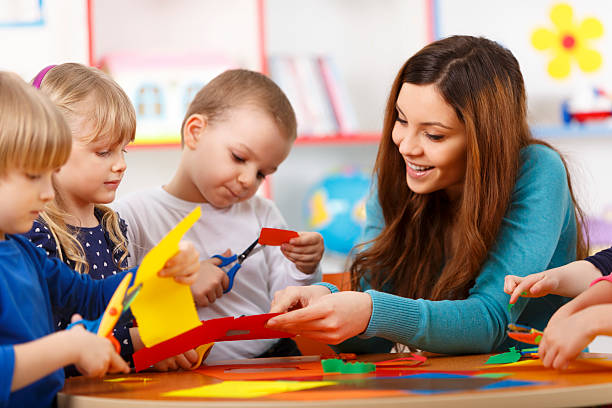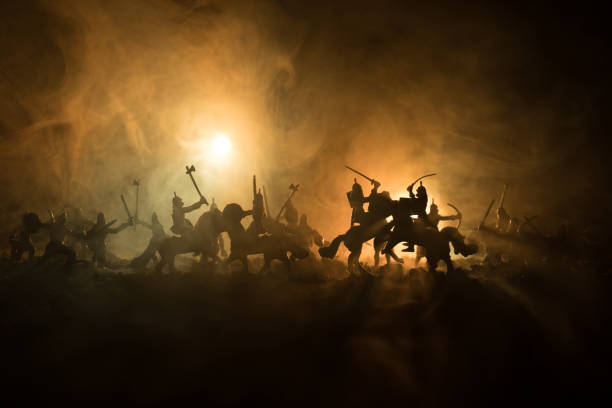How To Describe A Classroom In Writing (13 Best Tips)
How To Describe A Classroom In Writing
How To Describe A Classroom In Writing: Stepping into the world of descriptive writing requires more than just the mastery of language; it demands an astute ability to transform the ordinary into the extraordinary.
Among the myriad subjects worthy of exploration, the classroom stands as a captivating stage where the drama of learning unfolds.
Describing a classroom in writing is an intricate dance between observation, imagination, and the artful arrangement of words.
It’s not just about recounting the physical elements but capturing the intangible atmosphere, the dynamic interactions, and the subtle nuances that make each learning space unique.
In this journey, we delve into the nuances of how to vividly portray a classroom, exploring the elements that breathe life into the written word and transport readers into the heart of an educational realm.
From the meticulous arrangement of desks to the vibrant choreography of interactions, this exploration aims to uncover the secrets of crafting evocative descriptions that transcend the mundane and invite readers into the rich tapestry of the classroom experience.
How To Describe A Classroom In Writing
Describing a classroom in writing involves capturing its physical attributes, atmosphere, and any noteworthy elements. Here’s a step-by-step process on How To Describe A Classroom In Writing:
Introduction
Begin with a brief introduction to set the scene. Mention the type of classroom, its location, and perhaps its purpose (e.g., science lab, English classroom).
Physical Layout
Describe the physical layout of the classroom. Discuss the arrangement of desks or tables, their size, and how they are organized. Note the presence of a teacher’s desk, if applicable.
Decor and Colors
Highlight the colors used in the classroom and any decorations on the walls. Mention if there are educational posters, artwork, or other visual elements that contribute to the overall ambiance.
Furniture and Equipment
Discuss the type of furniture present, such as chairs, tables, or specialized equipment. Mention any technological tools like computers, projectors, or interactive whiteboards.
Lighting and Ventilation
Comment on the lighting in the room. Is it natural light or artificial? Mention the ventilation and how it contributes to the comfort of the space.
Educational Resources
Identify any educational resources available, such as textbooks, reference materials, or specialized tools used for teaching.
Atmosphere
Describe the overall atmosphere in the classroom. Is it quiet and focused, or is there a buzz of activity? Consider the mood that the physical space creates.
Seating Arrangement
Provide details on how students are seated. Are they in rows, clusters, or arranged in a specific pattern? Mention if there is a specific seating plan in place.
Teacher’s Presence
Discuss the teacher’s area, including the desk and any personal touches. Consider whether the teacher has a podium, board, or any specific tools for instruction.
Student Work
Observe any student work on display, such as projects, artwork, or assignments. Mention how the display contributes to the overall ambiance of the classroom.
Sound and Noise Level
Comment on the sound within the classroom. Is it hushed, lively, or somewhere in between? Consider how noise levels contribute to the learning environment.
Special Features
Note any unique features that stand out in the classroom, such as a reading nook, a class pet, or a designated area for group work.
Conclusion
Summarize the key elements of the classroom, reinforcing its overall atmosphere and functionality. Conclude with any personal impressions or reflections on the space.
Remember to engage the reader’s senses by incorporating descriptive language, and use specific details to create a vivid picture of the classroom.

Pre-writing Preparation
Embarking on the enchanting journey of pre-writing preparation is akin to donning the explorer’s hat in the vast wilderness of creativity.
Armed with the quiver of keen observation and the compass of purpose, writers navigate through the uncharted territories of their imagination.
Each stroke of the pen becomes a map, tracing the contours of a world not yet realized. The symphony of senses, tuned to the minutiae of surroundings, transforms mere details into the vibrant hues of a literary canvas.
In this prelude to creation, the dance of ideas commences, waltzing with purpose and pirouetting with intent.
As writers dive into the depths of understanding context and audience, they unearth the treasures that will embellish the tapestry of their words.
The pre-writing phase is not merely a preparatory step; it is an adventure, an odyssey where the muse whispers secrets and inspiration is born from the echoes of observation.
Observation and note-taking
Observation and note-taking are the alchemical tools that transmute the ordinary into the extraordinary in the realm of writing.
As a writer engages in a deliberate act of seeing, hearing, smelling, tasting, and touching the nuances of the world around them, the mundane undergoes a metamorphosis into a tapestry of inspiration.
The art of keen observation is not passive; it is an immersive experience where details become the building blocks of a vibrant narrative.
Note-taking, then, becomes the net that captures fleeting thoughts, ephemeral sights, and elusive emotions before they dissipate into the recesses of memory.
It is the act of freezing time, preserving the essence of a moment, and crystallizing the raw material of creativity.
In the dance between observation and note-taking, a writer not only witnesses the world but also becomes its chronicler, breathing life into words that resonate with the authenticity of genuine perception.
Establishing a purpose for the description
In the labyrinth of descriptive writing, establishing a purpose for the description is the compass that guides the writer through the maze of details.
Much like a skilled architect who envisions a structure before laying its foundation, a writer defines the raison d’être of their depiction.
Whether crafting an academic analysis, a vivid scene in fiction, or a persuasive piece, the purpose anchors the narrative, lending it direction and intent.
It’s the difference between a mere inventory of details and a carefully curated experience for the reader. A well-defined purpose becomes the North Star, influencing the choice of words, the depth of exploration, and the emotional resonance of the description.
It is the difference between a room merely being described and a room coming alive on the page, pulsating with significance.
In essence, establishing a purpose for the description is the art of infusing intention into observation, ensuring that every word serves as a purposeful stroke on the canvas of the reader’s imagination.
Elements of a Classroom Description
Navigating the intricate labyrinth of a classroom’s essence requires the writer to become an architect of words, molding the raw elements into a symphony of sensory delight.
The physical layout of desks and chairs, like chess pieces on a literary board, orchestrates a narrative dance. The decor, a gallery of ideas, whispers tales of creativity and inspiration.
Lighting, a maestro in its own right, conducts the ambiance with the precision of a virtuoso. Colors, like palette strokes, paint emotions on the canvas of the room.
Amidst the hum of technology, the classroom becomes a living organism, pulsating with the energy of learning.
Each element is a note, and the writer, the composer, crafts a symphony where the harmony of details resonates with the reader’s imagination.
In the alchemy of a classroom description, the elements cease to be mere components; they metamorphose into the building blocks of a captivating narrative, inviting readers into a world where every detail sings with purpose and vibrancy.
Physical Layout
The physical layout of a classroom is a choreography of spatial elements that orchestrates the rhythm of learning.
It is a canvas upon which the drama of education unfolds, with desks and chairs arranged like actors on a stage.
The size and shape of the room set the scene, determining the dynamics of interaction and the flow of energy.
Each desk becomes a plot point, a designated space where students engage with the unfolding narrative of knowledge.
The arrangement of furniture, whether in clusters fostering collaboration or in neat rows encouraging focus, shapes the very choreography of intellectual exploration.
The physical layout is not just a blueprint; it is a silent script that influences the ebb and flow of ideas, turning the classroom into a three-dimensional theater where education takes center stage.

Decor and Atmosphere
The decor of a classroom is the curator of its atmosphere, an artful symphony of visual elements that transforms the space into a haven of inspiration.
It is the tapestry of creativity that adorns the walls, whispering stories of imagination and curiosity. From educational posters that serve as beacons of knowledge to student artwork that paints the room with individuality, every element contributes to the visual ambiance.
The atmosphere, then, becomes an intangible yet palpable force, shaped by the colors, textures, and aesthetics that surround the learning environment.
A well-crafted atmosphere transcends mere decoration; it becomes the silent conductor orchestrating the emotional notes that accompany the intellectual journey within.
As students step into this adorned realm, they don’t just enter a room—they enter a sanctuary where the marriage of aesthetics and academia creates a harmonious space for growth and discovery.
Specific Details
Specific details in writing are the enchanting pixie dust that transforms a mundane description into a mesmerizing tapestry of vivid imagery.
Like a master illusionist revealing the secrets behind the trick, specific details unravel the ordinary, exposing the extraordinary hiding in plain sight.
They are the kaleidoscopic gems that catch the reader’s eye, drawing them into a world where each minutiae is a portal to a deeper understanding.
Whether it’s the idiosyncrasies of a teacher’s desk, the personalized artifacts adorning student workspaces, or the technological artifacts weaving through the classroom, these specifics breathe life into words, inviting readers to touch, smell, and hear the story unfolding before them.
In the dance of details, the ordinary metamorphoses into the extraordinary, and the writer, akin to an alchemist, turns the base metal of description into the gold of a captivating narrative.
Teacher’s Desk and Materials
The teacher’s desk is the command center of the classroom, a sanctum where knowledge takes shape and wisdom finds its voice.
It stands as a nexus between inspiration and instruction, an altar adorned with the tools of pedagogical artistry.
The meticulous organization of materials on this desk is a choreography of intellect, where lesson plans, worn textbooks, and vibrant markers converge.
Each item, from the ergonomic chair to the well-worn pencil cup, carries the weight of countless lessons and the echoes of students past.
The desk becomes a tableau vivant, telling the story of a mentor’s dedication through the carefully arranged educational artifacts.
This sacred space is not just an administrative hub; it is the epicenter of academic alchemy, where the teacher, armed with the philosopher’s stone of knowledge, transforms the mundane into the extraordinary for the eager minds seated beyond.
Student Desks and Personal Items
Student desks, scattered across the classroom like constellations in the vast cosmos of learning, are not mere furniture but living canvases that speak volumes about individuality.
Each desk is a microcosm, adorned with personal artifacts that tell the tale of its occupant. From dog-eared textbooks bearing the scars of scholarly pursuits to carefully doodled notebooks that harbor the creative whimsy of young minds, these desks are witnesses to the intellectual odysseys embarked upon by students.
Personal items—a forgotten pen, a cherished photo, or a well-loved novel—transform the sterile surfaces into intimate realms, each revealing a unique narrative.
As these miniature worlds unfold, the classroom transcends its utilitarian role, becoming a gallery of diverse identities and a testament to the vibrant mosaic of personalities gathered in pursuit of knowledge.
The student desks, with their trove of personal items, are not just places of study; they are reflections of the rich tapestry that is education.
Dynamic Elements
In the kaleidoscopic symphony of education, dynamic elements are the spirited dancers, infusing the classroom with vitality and rhythm.
From the spontaneous crescendo of a passionate discussion to the subtle choreography of students moving between desks, the room becomes a living, breathing entity.
These dynamic elements are the heartbeat of intellectual exchange, where ideas collide and harmonize in a dance of intellectual resonance.
The vibrant interactions between teachers and students, the kinetic energy of collaborative projects, and the pulsating cadence of evolving discussions create an ever-shifting landscape of intellectual engagement.
In this dynamic dance, time doesn’t just pass; it pirouettes, and learning becomes a rhythmic journey where every step propels the narrative forward.
The classroom transforms into a stage, and the dynamic elements are the performers, turning the act of education into a captivating ballet where every movement leaves an indelible mark on the minds of those who participate.
Interactions and Activities
Interactions and activities within the classroom are the heartbeat of the learning experience, transforming the space into a vibrant arena of intellectual exchange.
Each interaction between students and teachers is a brushstroke on the canvas of understanding, painting a picture of collaboration and shared knowledge.
From lively discussions that spark intellectual fire to collaborative activities that weave a tapestry of shared experiences, these interactions are the crucible where ideas are forged and comprehension deepens.
The classroom is not just a static backdrop but a dynamic stage where the drama of learning unfolds. Every engagement, whether a spirited debate or a hands-on experiment, becomes a pivotal scene, contributing to the evolving narrative of education.
In the symphony of interactions and activities, the classroom transcends its physical boundaries, becoming a crucible of growth, where minds engage, ideas collide, and the seeds of knowledge blossom into wisdom.

Time and Movement
In the intricate dance of education, time becomes a silent choreographer, and movement, its most expressive dancer. The ticking clock is the metronome, setting the rhythm for the ebb and flow of intellectual tides.
Each moment is a pirouette, a fleeting opportunity for discovery, as students traverse the temporal landscape of lessons and discussions.
The movement is not just physical; it is the migration of ideas from one mind to another, the evolution of understanding as concepts unfold.
In this temporal ballet, the classroom becomes a stage where the drama of learning unfolds, and every transition, every step forward, is a progression in the narrative of knowledge.
The interplay of time and movement transforms the learning space into a dynamic continuum, where the past informs the present, and the future is shaped by the collective motion of engaged minds.
Revision and Refinement
Revision and refinement are the alchemical crucibles where raw creativity is forged into the polished gold of literary brilliance.
It’s the laboratory where words undergo a metamorphosis, evolving from mere ink on paper to a symphony of eloquence.
Like a sculptor refining a block of marble, the writer chisels away excess, revealing the intricate contours of their narrative sculpture.
Revision is not just correction; it’s a surgical precision, a delicate dance where each word is scrutinized for its contribution to the grand composition.
Refinement, then, is the artist’s brushstroke, adding nuanced shades and layers that elevate the piece to a masterpiece. It’s a process where imperfections are not flaws but opportunities for enhancement.
In this crucible of revision and refinement, writing ceases to be a static endeavor and becomes a dynamic, ever-evolving journey toward literary perfection.
It’s not just about rewriting; it’s about crafting a narrative opus that resonates with the reader’s soul.
Revisiting initial observations and notes
Revisiting initial observations and notes is akin to returning to a cherished novel, discovering new facets in the familiar narrative.
It is the literary archaeology where the writer, armed with newfound perspectives and insights, unearths the treasures buried in their initial impressions.
Much like a seasoned detective revisiting a crime scene, the writer rediscovers the subtle nuances and hidden gems overlooked in the initial sweep.
The process is not just about correction but a journey of rediscovery, where the writer becomes both archaeologist and storyteller.
Revisiting those initial notes is an invitation to revisit the emotions, the ambiance, and the essence of the observed, transforming the writing process from a mere recounting of details to a rich, layered narrative that captures the full spectrum of the observed experience.
Incorporating feedback from peers or mentors
Incorporating feedback from peers or mentors is akin to inviting seasoned navigators to chart the course through the vast sea of words.
It transforms the solitary act of writing into a collaborative symphony, where each note is refined and harmonized through the collective wisdom of others.
Peers and mentors become literary architects, offering insights that illuminate blind spots and suggestions that fortify the narrative structure.
It’s a symbiotic dance between vulnerability and growth, as the writer opens themselves to constructive critique, recognizing that every suggestion is a brushstroke contributing to the masterpiece.
In this exchange, feedback is not just correction; it is a dialogue that enriches, refines, and shapes the narrative into a more resonant and impactful expression.
The act of incorporating feedback is not only a testament to humility but a celebration of the collective effort that transforms a piece of writing from good to extraordinary.
Frequently Asked Questions about How To Describe A Classroom In Writing:
Why is it important to describe a classroom in writing?
Describing a classroom in writing helps create a vivid and immersive experience for readers. It sets the scene, enhances storytelling, and provides valuable context for educational or narrative purposes.
What details should I focus on when describing the physical layout of a classroom?
Pay attention to the arrangement of desks, the presence of a teacher’s desk, the type of furniture, and the overall organization of the space. Consider how these elements contribute to the functionality and atmosphere of the classroom.
How can I capture the atmosphere of a classroom in my description?
Use descriptive language to convey the mood and energy in the room. Consider factors like lighting, noise levels, and the overall vibe. Reflect on how these elements contribute to the learning environment.
Is it necessary to mention the colors and decorations in the classroom?
Yes, discussing colors and decorations adds depth to your description. It helps create a visual image of the environment and may provide insights into the educational theme or atmosphere of the class.
What role does technology play in describing a modern classroom?
In a modern classroom, technology is significant. Describe the presence of computers, projectors, interactive whiteboards, or any other tech tools. Explain how these contribute to the learning experience.
Should I include details about the teacher’s presence in the classroom?
Absolutely. Mention the teacher’s desk, any tools used for instruction, and personal touches in their area. This adds a human element to your description and provides insights into the teaching style.
How can I convey the sound and noise level in the classroom effectively?
Use descriptive adjectives to characterize the sound environment. Is it a quiet, focused atmosphere, or is there a buzz of activity? Consider how the noise level contributes to the overall ambiance.
Are there specific features or elements that make a classroom unique?
Yes, look for unique features like a reading nook, class pet, or special display areas. These elements add character to the classroom and make it stand out in your description.
Can I incorporate personal reflections in my description of a classroom?
Absolutely. Sharing personal impressions or reflections can add authenticity to your writing. Describe how the classroom made you feel or any unique experiences you associate with the space.
How do I conclude my description of a classroom effectively?
Summarize the key elements of the classroom, reinforcing its overall atmosphere and functionality. Conclude with a sentence or two that leaves a lasting impression or ties back to the purpose of your description.
Conclusion
In conclusion of How To Describe A Classroom In Writing, describing a classroom in writing is an art that involves meticulous observation and thoughtful expression.
By weaving together details about the physical layout, atmosphere, and unique features, you can paint a vivid picture that transports readers into the heart of the learning environment.
Remember to engage the senses through descriptive language, providing not just a visual image but also a sense of the mood, energy, and purpose within the four walls.
Whether it’s the arrangement of desks, the colors adorning the walls, or the subtle nuances that make each classroom unique, a well-crafted description invites readers to experience the space firsthand.
Through this process, writers have the power to evoke nostalgia, curiosity, or a sense of familiarity, creating a literary tapestry that captures the essence of the educational setting.






